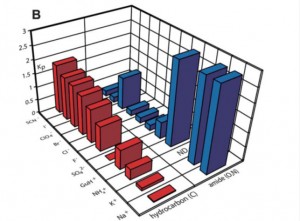If you take two glasses of water and dissolve sodium chloride in the one and sodium iodide in the other, I can tell you that in the first glass you have a deficiency of anions in the water-air interface and an accumulation of negative ions in the same interface in the latter glass. I can also tell you that if you dip a glass stirrer into one glass it will become negatively charged, where it in the other will get a positively charged. The last piece of wonder I can share is that if you use a plastic spoon instead the effects are reversed.
The examples I gave above are all examples of Hofmeister effects, where the nature of a small ion dictates specific events to occur in larger systems. The example with iodide and chloride are not the most extreme and the effects described above are small. The extreme cases include sulphate, perchlorate and hexafluorophosphate, the former is extremely hydrophilic and the two other are very lipophilic. Cations are an altogether different story all-together.
The importance of the Hofmeister effects are not to be underestimated as all biological processes and structures have to exist in ion-rich environments. Strip away the ions or introduce large quantities of an alien small ion and the processes and structures are disrupted. Killing an organism by introducing potassium is an easy experiment. Understanding the effects of chloride, bromide and sodium on every single piece of the biological machinery is much more challenging. The challenge is being met by the group of researchers who attended the 160th Faraday Discussion on Ion Specific Hofmeister Effects. Their latest findings and a thorough introduction to the subject is published in the recent issue of Faraday Discussions.
Much, much more information and many insights can be gleaned in the themes issue of Faraday Discussion on Ion Specific Hofmeister Effects.
by Dr Thomas Just Sørensen











